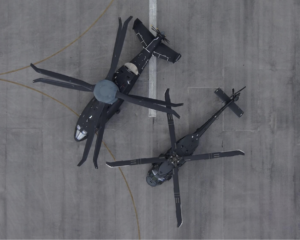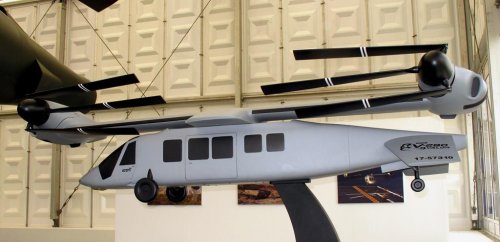
April 10, 2013 Bell Helicopter introduced the V-280 “Valor” tilt-rotor at the 2013 Army Aviation Association of America’s (AAAA) Annual Professional Forum and Exposition.
This is only the latest entry in the Future Vertical Lift (FVL) Program, “A collaborative effort involving a number of parties, including Special Operations Command (SOCOM), the U.S. Coast Guard, NASA, the Office of the Secretary of Defense (OSD) and the Vertical Lift Consortium (VLC), FVL will design, develop and deliver the next generation of DoD vertical lift aircraft, according to Lt. Col. David Bristol, U.S. Army Aviation PEO for Future Vertical Lift activities.”
The program is meant to develop a replacement for the UH-60 Black Hawk, AH-64 Apache, and CH-47 Chinook.
“The Bell V-280 Valor’s Army-centric design boasts a number of unmatched capabilities and transformational features including:
- Speed: 280 KTAS cruise speed
- Combat range: 500-800nm
- Strategically Self-Deployable – 2100nm Range
- Achieves 6k/95
- Non-rotating, fixed engines
- Triple redundant fly-by-wire flight control system
- Conventional, retractable landing gear
- Two 6′ wide large side doors for ease of ingress/egress
- Suitable down wash
- Significantly smaller logistical footprint compared to other aircraft”
“The Bell V-280’s clean sheet design reduces complexity compared to previous generation tiltrotors, with fewer parts, as well as non-rotating, fixed engines.”
Hopefully some day we may be able to fulfill the medium range search requirement with the same aircraft that provides the long range rescue capability, and this replacement for the H-60 will have twice the range and almost twice the speed of its predecessor.

Pingback: “Coast Guard awards hull contract as part of MH-60T sustainment effort” –CG-9 | Chuck Hill's CG Blog
Sikorsky version of H-60 replacement. https://breakingdefense.com/2021/01/defiant-x-sikorsky-boeing-unveil-flraa-design/?_ga=2.135064177.1146656124.1611574871-493340525.1611574871
The FLRAA options makes me wonder where this will leave the USN and to some extent the USCG, in the long run.
Neither option gives the appearance of being able to be folded up into spaces that accommodate the MH-60S, let alone the MH-60R (and the USCG MH-60T)
Sure, this ‘problem’ is likely decades down the road. But, likely something that should start being thought about. Hangers on existing ships don’t really have growth potential.
Fitting into the same space as the H-60 is part of the plan.
@Chuck



Sorry, but there is no requirement to fit into USN and USCG hanger spaces. As these branches have never been part of the program.
The Army requirement is to fit into a similar HLZ surface space.
The USMC want it to fit onto/into LHA decks and hangers. That were designed to accommodate the overall height of aircraft like the CH-46 and CH-53. There is no requirement for either aircraft to fold up and fit into hanger spaces used by USN Sierras or Romeos. Nor USCG Tangos.
The massive height of the Sikorsky/Boeing Defiant rotor mast is a major problem shipboard. And, while overall fuselage length is comparable to -60 variants,
figuring out how to fold one up will take Master degrees in Origami and a touch of magic
As for Bell’s V-280. Even if they design and build a rotating wing box like the V-22,
you again encounter issues with the overall height limitations in surface combatant hangers. And, it’s overall wing diameter appears to exceed the full, unfolded length of the -60 variants
And, as if to substantiate my concerns, the Navy appears to striking out on their own path
https://twitter.com/TheDEWLine/status/1354868773237497858
@Chuck
Giving it some thought. I have to wonder if the USN & USCG could meet their requirements for Maritime Strike(ASW/ASUW) & CSAR/SAR with a smaller platform. Like something along the line of Sikorsky’s S-97 Raider. Sikorsky has pushed it in ISCG colors in it’s brochures. t.ly/bDvg
And, perhaps with such an aircraft it might make more sense to transition to a single type, replacing both the MH-60 and MH-65 platforms.
Obviously, the USCG can not go it alone to field something like the Raider.
I think is is less a question of having only one type of vertical lift aircraft and more a question of will we still need the smaller fixed wing aircraft like the HC-144. Certainly think we will have two sizes of vertical lift aircraft, Larger for long range and smaller to do local work and fly off ships. But the larger versions will likely be able to do everything the C-144 can do. They will be able to go seamlessly from the search phase to the rescue phase.
@W B Y, The S-97 Raider is one of the prototypes being considered for the Army lead Future Vertical Lift program. I expect something similar will replace the H-65. looking at the specs, I note that the rotor diameter of the S-97 is five feet less than the H-65.
The Coast Guard has really shown little interest in operating their H-60s from ships. They don’t follow the SeaHawk in either landing gear arrangement or ability to fold the tail.
OK, the S-97 Raider did not originate as part of the Army FVL program. Sikorsky developed the S-97 on their own, and part of their X2 Technology program. (was their eye on FVL projects? Sure)
Now, when the Army opened the Future Armed Reconnaissance Aircraft (FARA) program Lockheed/Sikorsky presented the S-97 as a technology demonstrator (think of it as proof of risk reduction). When they submitted their actual FARA bid, it was the Raider X, developed from the S-97. But it’s not the same aircraft in a real sense. It’s a bit bigger and uses a much more powerful engine. And, has no design intention (currently) to be able carry passengers. And Sikorsky lists them as different aircraft projects.
Clear as mud…lol
Yeah, the coaxial rotor configuration allows for a reduced rotor disk diameter. But you must accommodate the significantly increased rotor mast height.
I was wondering about how the USCG currently, and in the future will, employ their Jayhawks (& replacements). I assumed they were primarily land based. But recall reading that they were seeing deployments on larger cutters. I assumed this meant the WHEC & WMSL. And, if I recall correctly, there had been cases of USN Seahawks operating from them as well.
I guess it would boil down to how the USCG envisions they will use any Jayhawk replacement in deciding on specific platform configuration. My understanding is that tilt rotors have been shown have a problem conducting hoist operations. The reduced blade length, and thus smaller rotor disk, means they must produce a more forceful air stream downward. Causing a more volatile surface condition. IIRC this played a role in the USAF opting to stay with a -60 variant instead of fielding the V-22 as their CSAR platform.
The USN field two different ‘Seahawk’ platforms. The ‘Romeo’ (MH-60R) shares a direct lineage with the Jayhawks thru the HH-60H/HH-60J development. They share fuselage configurations (door, window, external fuel tank, port side stores pylon and yes, landing gear). The ‘Sierra’ (MH-60S) Seahawk is configured basically the same as standard Army Blackhawks. Notably with the rear landing rear toward the end of the tail boom. As opposed to the Jayhawk and ‘Romeo’ where it is at the fuselage/tail boom base. Now, I do not know if the USCG does or does not fold the tails of their Jayhawks. But I have seen plenty of images where the hinges/latches are visible in the same place as the USN aircraft.
Both the Navy and the Coast Guard are intimately involved in the FVL project. And the manufacturers certainly do not want to forgo the naval market for the aircraft they are developing. The CG clearly plans to use products of the FVL development.
And yes the NSC and OPC aviation facilities are or will be qualified to handle Navy H-60s including hangaring them.
“Navy May Look to Army’s Future Vertical Lift Program for Seahawk Replacement” https://www.military.com/daily-news/2021/02/02/search-navys-next-gen-maritime-strike-helicopter.html
This is essentially a long advertisement, but it is interesting. https://www.lockheedmartin.com/fvl/?utm_source=defense_news_ebb&utm_medium=native&utm_campaign=fvl&utm_term=defiant_x_reveal&utm_content=feb22
This is about the H-60 replacement with the actual program scheduled to begin in FY-2022.
https://www.defensenews.com/land/2021/03/31/us-army-enters-final-phase-of-development-before-kicking-off-future-long-range-assault-aircraft-program/
According to this time line, the Army will get the first units to field operators in 2030.
https://www.defensenews.com/land/2020/07/28/army-still-mulling-different-paths-to-build-long-range-assault-helo-prototypes/
Marine views on Future Vertical Lift. https://news.usni.org/2022/02/09/marines-want-vtol-family-of-systems-for-future-vertical-lift
“Sikorsky-Boeing SB-1 Defiant demos single-engine, sling-load and slalom flight” https://www.flightglobal.com/helicopters/sikorsky-boeing-sb-1-defiant-demos-single-engine-sling-load-and-slalom-flight/147603.article
Tough Budget Environment Raises Stakes for Army’s Decision on Future Long-Range Assault Aircraft https://www.realcleardefense.com/articles/2022/03/03/tough_budget_environment_raises_stakes_for_armys_decision_on_future_long-range_assault_aircraft_819778.html
More on the smaller FARA aircraft and possibly a new engine for the H-60.
https://breakingdefense.com/2022/04/after-delay-engine-for-armys-fara-prototypes-set-for-november-delivery/?utm_campaign=Breaking%20Defense%20Air%20&utm_medium=email&_hsmi=209434782&_hsenc=p2ANqtz-9VupsZYb2eCS-abeSYtuHk0UQagADeGiiV_gUMn11m4bi4JVqpFGqTAJzys-CUTr7e9yWxLvLNA7I4rXqPHg4Eokg37Q&utm_content=209434782&utm_source=hs_email
“The service is expected to make a decision on its future long-range assault aircraft, or FLRAA, program this fall, a decision so imminent that the Army has entered a “quiet period” on the competition.” https://www.nationaldefensemagazine.org/articles/2022/5/23/aviation-giants-enter-final–stretch-to-replace-black-hawk
Two articles concerning future vertical lift
First looks primarily at one of the candidates for the smaller aircraft, Sikorsky’s Raider X. https://www.thedrive.com/the-war-zone/raider-x-lockheed-martin
Second is a “The Navy Has Begun To Hunt For Its MH-60 Seahawk Helicopter And Fire Scout Drone Replacements” is a much earlier (Jan. 31, 2021) I had not seen before. https://www.thedrive.com/the-war-zone/39013/the-navy-has-began-its-hunt-to-replace-its-mh-60-seahawk-helicopters-and-fire-scout-drones
Testing for new engine that is expected to power future vertical lift aircraft and provide upgrade for H-60s https://www.defenseone.com/business/2022/07/army-finishes-early-testing-next-generation-helicopter-engine/373973/
Bell/Textron Says Keeping Future Vertical Lift On Track Is Critical To Renewing The Rotorcraft Industrial Base https://www.forbes.com/sites/lorenthompson/2022/08/02/belltextron-says-keeping-future-vertical-lift-on-track-is-critical-to-renewing-the-rotorcraft-industrial-base/?sh=425fcc866d5b
Sometime later this year, probably in October, the U.S. Army will disclose the winner of a competition to provide the successor for its venerable Black Hawk helicopter.
Interesting aspect of the way these aircraft are being configured.
https://www.defensenews.com/native/Sikorsky-Lockheed-Martin/2023/07/10/raider-x-digital-backbone-drives-mosa-success-for-the-army/
This new engine may be used to reengine CG helicopters.
“FARA Competitors Start T901 Engine Certification, Installation Process” https://aviationweek.com/defense-space/aircraft-propulsion/fara-competitors-start-t901-engine-certification-installation?elqTrackId=D3A344E31FACE22984C5DA05676B2803&elq=4931586c47fc40c497f41ece655da651&elqaid=40880&elqat=1&elqCampaignId=34116&utm_rid=CPEN1000003064635&utm_campaign=40880&utm_medium=email&elq2=4931586c47fc40c497f41ece655da651&utm_emailname=AW_News_Aerospace_20231025&sp_eh=5523453291ad8abe1dfe4890dda2242e2cc9e3b0fb78a1b5f2ae15a3aaf8aa35